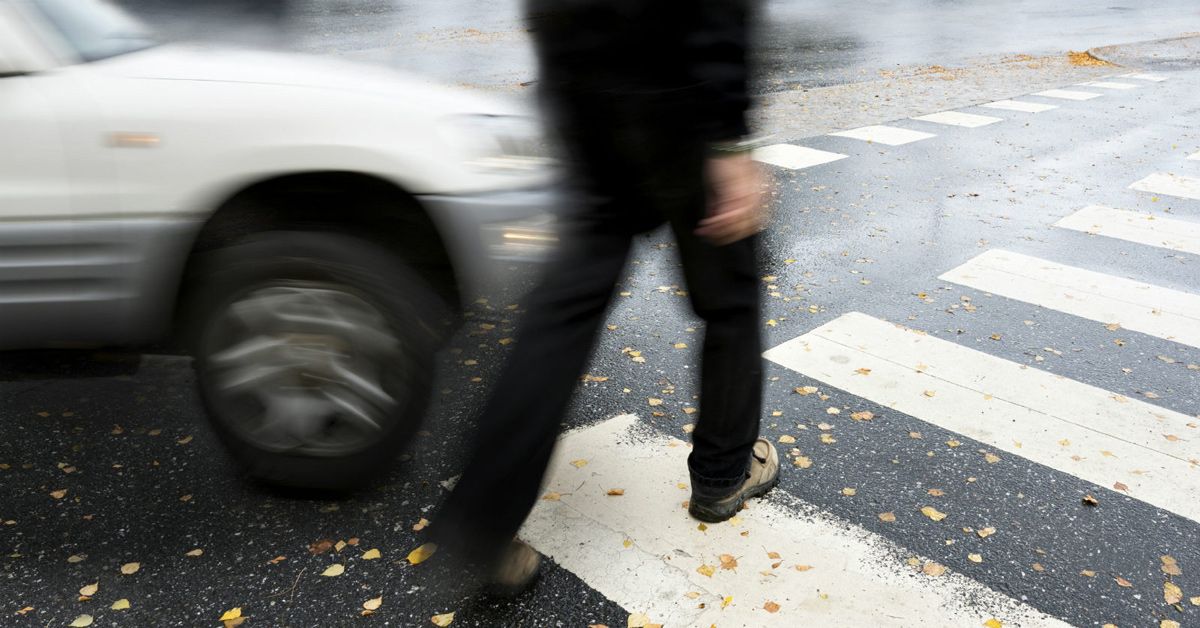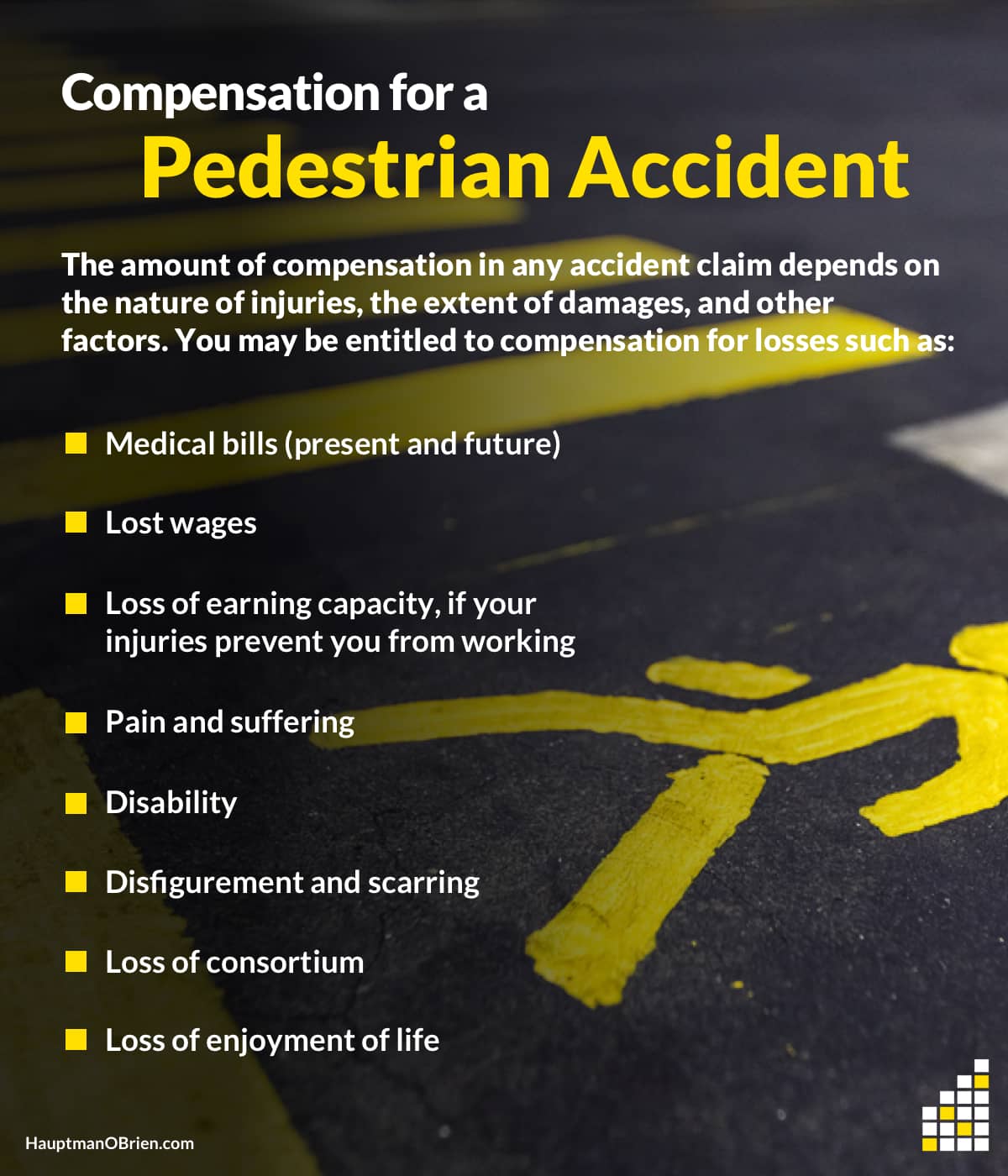When a pedestrian is hit by a motor vehicle, they often suffer catastrophic injuries. Getting compensation for your injuries after a pedestrian accident isn’t easy. It requires filing claims with insurance companies, keeping records of medical bills, and a time-consuming investigation of the accident. And even if a motor vehicle driver was clearly at fault, there is no guarantee you will receive a fair settlement offer from the insurance providers.
If you or a loved one were hit by a motor vehicle as a pedestrian in Nebraska, the Omaha pedestrian accident attorneys at Hauptman, O’Brien, Wolf & Lathrop are here to help you pursue the compensation you need to cover medical bills, lost wages, and other damages.

What Is a Pedestrian?
A pedestrian can be defined as anyone who is not traveling in a motor vehicle.
This term is not limited to those who are traveling on foot but includes cyclists, skateboarders, and rollerbladers as well. Whether your car is your primary means of transportation or not, chances are you are a pedestrian at some point every day.
Pedestrian Accident Injury Statistics
In 2019 (the most recent year of data), the Nebraska Department of Transportation recorded 342 vehicle accidents involving pedestrians. Statistics for injuries in these accidents include:
- Visible injury (not disabling): 137
- Possible injury (not visible): 133
- Suspected serious injury: 72
A total of 20 pedestrians were killed in accidents in 2019. Although only 0.9 percent of accidents in Nebraska involve pedestrians, pedestrian accidents account for 9.4 percent of fatal crashes in the state.
Preliminary data from the National Highway Traffic Safety Administration show that 6,205 pedestrians were killed in accidents nationwide in 2019. This marks a decrease of nearly 3 percent from the prior year.
Sources:
Nebraska Department of Transportation – Highway Safety/Accident Records Section, Nebraska Crash Facts 2019 Annual Report
National Highway Traffic Safety Administration, Preview of Motor Vehicle Traffic Fatalities in 2019
Causes of Pedestrian Accidents
Pedestrian accidents may be caused by a driver, the pedestrian, or a combination of both. In many cases, either the pedestrian or the driver were acting negligently by failing to pay attention or take proper safety precautions.
As attorneys, when we handle pedestrian accidents cases where the driver is at fault, it’s often because they:
- Were speeding
- Failed to yield to the pedestrian
- Were driving while distracted
- Were driving under the influence of alcohol or drugs
- Were driving a vehicle that suffered equipment failure (bad tires, lost brakes, etc.)
In contrast, when the pedestrian is at fault for the accident, it may be because they:
- Ignored a traffic signal
- Jaywalked
- Were walking in or near high-speed traffic
- Were walking on the roadway instead of the sidewalk
- Were intoxicated or under the influence of drugs

Why You Need a Pedestrian Accident Lawyer
Many people who are involved in pedestrian accidents believe that their case is straightforward enough to carry on without a lawyer. The truth is, just because you were hit by a motor vehicle doesn’t automatically entitle you to the settlement you deserve. Insurance adjusters will even deny your claim outright depending on certain factors. Because of these risks, you need an experienced pedestrian accident lawyer on your side. Below are three reasons why you should consider contacting Hauptman, O’Brien, Wolf & Lathrop after your pedestrian accident in Omaha.
You Are Too Injured to be Burdened with Legal Matters
It is entirely possible that after being struck by a motor vehicle that you are too injured to balance legal matters and monitor your health. It is not uncommon for victims of these accidents to have broken bones and brain trauma that prohibit them from leaving the hospital and their home for extended amounts of time. We want you to know that we will take the stress of the legal process completely off of your plate while you concentrate on healing.
Our Pedestrian Accident Lawyers Can Identify Those At Fault
Unfortunately, insurance adjusters have been known to deny a claim on the basis that it wasn’t the driver’s fault that you sustained injuries. Our pedestrian accident lawyers will work to show that this was, in fact, not the case and that the driver was liable for your injuries. We will collect evidence, interview witnesses and present viable information that will provide strength to your case. Even if the accident was partially your fault – you were jaywalking, but the driver was texting – we can work to prove that the driver was more at-fault.
Negotiating Your Settlement
It’s likely that you will be offered a lowball settlement offer for your pedestrian accident claim at first. Our personal injury lawyers will be able to provide you with guidance and advice about whether or not the insurance company’s offer is fair or not. If it is not, our lawyers will be able to determine what is fair based on the damages you have suffered. If the insurance company does not pay what we determine to be a fair settlement, our lawyers are not afraid to further pursue your claim in a courtroom.
Pedestrian Accident Injury Compensation
The risk of a pedestrian dying in an accident is directly related to the speed the car is traveling. According to AAA, if a car hits a pedestrian while traveling at 23 mph, there is a 10 percent chance the pedestrian will be killed.
This risk increases exponentially with speed. At 32 mph, the risk is 25 percent; at 42 mph it is 50 percent; at 50 mph it is 75 percent; and at 58 mph the chance of pedestrian death is 90 percent. If the vehicle is a truck or tractor trailer, the chance of death is even higher.
If the pedestrian survives the accident, they are often severely injured or permanently disabled. Some of the injuries that can occur during a pedestrian accident include:
- Broken bones
- Burns
- Internal bleeding/organ damage
- Traumatic brain injuries (TBIs)
- Neck and back injuries
- Spinal cord injuries (SCIs)
- Ligament or disc injuries
Using common sense as a pedestrian can help you stay safe. Doing simple things like walking on the sidewalk, crossing only at crosswalks, and walking against the flow of traffic can go a long way toward preventing pedestrian accidents. Unfortunately, you can’t account for the actions of others. Innocent pedestrians are hurt and killed every day. Whether you’re hit by someone who didn’t see you as they were backing out of a parking spot or struck by a driver under the influence of alcohol, you have a right to seek compensation for your damages.
If you were injured or a loved one suffered wrongful death as a pedestrian, the best thing you can do to protect your rights is work with a pedestrian accident attorney. At Hauptman, O’Brien, Wolf & Lathrop, P.C., our attorneys are here to help you through this difficult time and fight for the compensation you need. Call us at (402) 241-5020 or contact us online to schedule your free consultation.
Pedestrian Accident FAQ
What Are the Main Causes of Pedestrian Accidents?
In many cases, pedestrian accidents are caused by the negligence of the driver of a motor vehicle. Examples of negligence that can lead to pedestrian accidents include:
- Distracted driving: Texting and driving, talking on the phone, talking to passengers, eating, and applying makeup are all common sources of driver distraction. Distracted drivers often fail to spot other cars before crashing, let alone somebody walking across the street.
- Excess speed: Drivers who are speeding have less time to brake and take evasive action to avoid a collision. Even if they look both ways, pedestrians may be caught unawares by a vehicle that is going too fast, and the driver may not be able to stop in time.
- Taking corners too quickly: Drivers executing right and left turns need to check crosswalks for pedestrians before proceeding. If they fail to do so, they might cause an accident.
- Running a stop sign or red light: Ignoring traffic signals and signs can quickly turn an intersection into the scene of an accident. However, drivers who run red lights and stop signs generally also fail to check crosswalks, putting pedestrians in danger as well.
- Driving while intoxicated: Alcohol and drugs diminish visual acuity, reaction time, and good judgment. Drivers who are under the influence are much more likely to be in an accident with other motorists as well as pedestrians.
Parking lots and driveways are also common sites of pedestrian accidents. Drivers who fail to look behind their vehicle when backing out may hit or run over a pedestrian. Even at slow speeds, such an accident can result in serious injury – especially for small children.
How Can Pedestrians Avoid Accidents?
Although the drivers of motor vehicles are responsible for watching out for pedestrians and sharing the road with them, people on foot can reduce the risk of an accident as well. Follow these tips to reduce your chances of being injured in a pedestrian accident:
- Always look both ways: The time-honored lesson from childhood is valuable advice at any age. Whenever you are crossing the street, make sure there is enough distance between your path and any vehicles coming from either direction.
- Use marked crosswalks whenever possible: Jaywalking significantly increases the risk of being hit by a car. Although pedestrian accidents can still occur in marked crosswalks, using these designated areas makes you more visible to motorists and reduces the likelihood of a crash.
- Wear light-colored clothes: If you are walking after dark, you need to be as visible as possible. Clothing that is light in color and/or outfitted with reflective elements helps you stand out at night to drivers on the road.
- Mind the weather: Snow, rain, ice, and fog are dangerous conditions for drivers and pedestrians alike. In addition to the reduced visibility caused by inclement weather, people on foot may slip and fall in the road, placing them in the path of oncoming vehicles.
- Ignore distractions: When you are walking, it is important to stay focused on where you are going and what’s ahead of you. Distractions such as texting, making phone calls, listening to music, and more make it easy to miss potential dangers, including motor vehicles.
- Don’t walk while intoxicated: Alcohol and drugs impair judgment and reduce coordination. These issues limit your ability to identify potential dangers and act (and react) accordingly.
Caution is crucial when you are a pedestrian. Although you cannot control the negligence of drivers, you can take steps to keep yourself safe.
Where Are Pedestrians Most Likely to Be Hit by a Car?
According to the Centers for Disease Control and Prevention, “Most pedestrian deaths occur in urban areas, at non-intersection locations, and at night.” These insights are not surprising:
- Urban areas typically have more traffic – both pedestrians and motor vehicles. As a result, cars are more likely to come into contact with people on foot in cities and towns than they are in rural areas.
- Non-intersection locations are generally unmarked. The purpose of crosswalks (which are generally located at intersections) is to give pedestrians a safe place to cross the street. Generally, motorists are accustomed to slowing down and stopping in these areas. When pedestrians stray into the road from these designated areas, however, drivers are less prepared, which increases the risk of an accident.
- Visibility issues make walking at night dangerous: Some roads have better lighting than others. Although pedestrian accidents can happen anywhere at night, the riskiest areas are those with insufficient lighting.
So, if you are walking in an urban area (such as Omaha), walking outside of a marked intersection, and/or walking at night, it is important to be doubly cautious.
Source:
Centers for Disease Control and Prevention, Pedestrian Safety
What Happens If a Pedestrian Causes an Accident?
If you are at fault for an accident involving a motor vehicle while you were walking, you may be concerned about being unable to recover compensation for your injuries. Fortunately, Nebraska law allows at-fault individuals to pursue damages up to certain limits.
Under the law of comparative negligence in Nebraska, you may be entitled to compensation for a portion of damages so long as you are less than 50 percent at fault for the pedestrian accident. Your recovery will be reduced in proportion to your share of the fault.
What Is the Typical Settlement for a Hit Pedestrian?
Settlement amounts in any accident claim vary depending on the nature of injuries, the extent of damages, and other factors. The more important question is: What compensation may be available in your pedestrian accident case?
You may be entitled to compensation for losses such as:
- Medical bills (present and future)
- Lost wages
- Loss of earning capacity, if your injuries prevent you from working
- Pain and suffering
- Disability
- Disfigurement and scarring
- Loss of consortium
- Loss of enjoyment of life
A settlement is not the only option for recovering these and other damages in your pedestrian accident claim. If the at-fault driver’s insurance company refuses to compensate you fairly, your attorney can file a lawsuit on your behalf to pursue the compensation you deserve.
What Should I Do After a Pedestrian Accident?
If you have been seriously injured in a pedestrian crash, your first priority is to call 911. Unless you are in danger, try not to move. Emergency workers will evaluate your injuries, and they may take you to the hospital directly from the scene of the accident.
After receiving medical treatment, it is in your best interest to contact a pedestrian accident lawyer as soon as possible. Our attorneys can help with multiple aspects of your claim, including:
- Investigating and documenting the scene of the accident
- Requesting a copy of the police report
- Interviewing witnesses
- Determining the cause of the accident and who is at fault
- Hiring experts to review your medical records and other evidence
Hiring a lawyer after a pedestrian accident enables you to focus on recovering from your injuries. Your attorney can handle all aspects of building your claim, negotiating with the insurance company, etc. on your behalf.


